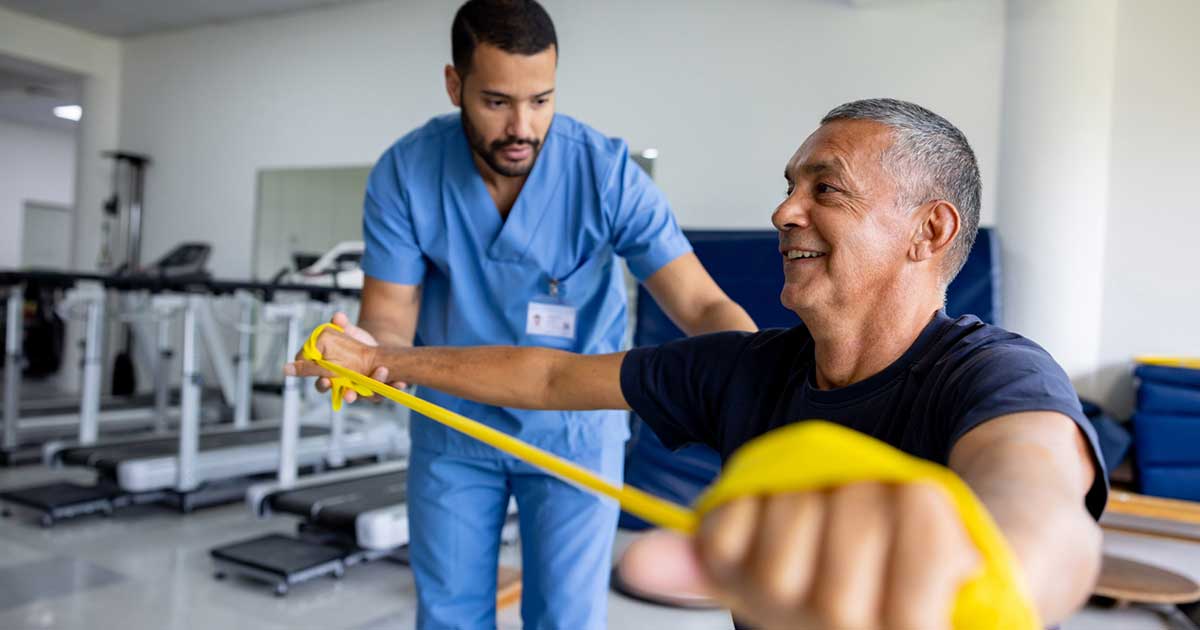What Is Prehab and Why Would You Need It?
Advice to improve your movement, fitness, and overall health from the world's #1 in orthopedics.
You’re probably familiar with rehabilitation, the healing process one goes through after getting hurt or having surgery. But you may not have heard the term “prehabilitation,” or “prehab”— a process that helps a person prepare for surgery so they can withstand any weakening that might happen afterward.

Prehab is standard procedure at HSS. And more and more people are discovering its value.
“The stronger you are going into surgery, the stronger you will be coming out of surgery,” says Erica Fritz Eannucci, DPT, OCS, CMP, SFMA, a physical therapist at HSS Paramus. “After almost any surgery, patients will see a decline in their strength, flexibility, balance, and endurance. If a person has worked to grow stronger before surgery, the drop off won’t be as bad.”
Who Is Prehab For?
Prehab can be useful before almost any surgery, but it’s particularly helpful for those who haven’t been active or those who are very anxious about the surgery. “It’s also very valuable for patients who will need a long period of immobilization [limited movement] or have limits on how much weight they can bear after surgery, because these patients typically experience the greatest decline in strength, range of motion and mobility,” says Fritz Eannucci.
Contrary to what you might think, almost anyone can do prehab, even those who are in pain before joint replacement surgery. “More often than not, a physical therapist or performance specialist can help to work around the affected area to build strength in the surrounding muscles,” says Fritz Eannucci.
The Perks of Prehab
There are many benefits of prehab. Some include:
- It may reduce recovery time. While the time it takes for your tissues to heal may not be changeable, going into surgery stronger and more flexible can help you return to activity faster once you’re cleared.
- It may help you go home faster. At prehab for joint replacement surgery, patients learn their exercises for after surgery and review any precautions, as well as practice using an assistive device like a walker or cane, among other things. “This allows them go into surgery more confident in their ability to move around after the procedure, which means they may be able to go right home after surgery instead of to inpatient rehab,” says Fritz Eannucci. “In fact, we’ve seen an overall trend in fewer patients going to inpatient rehab facilities after orthopedic surgeries. This may be due to prehab, in addition to other changes in how surgeries are done. Many of our patients even go home the same day.”
- It may help reduce complications after surgery. Similarly, learning to use crutches, canes or walkers in prehab can help patients get around better after surgery, reducing the risk of fracture from a fall, says Fritz Eannucci.
- It helps build confidence. Patients can ask questions and practice different activities they’ll do after surgery such as climbing stairs, walking, getting in and out of a car and other so-called activities of daily living. Data has shown that these programs can improve patient satisfaction, experiences and outcomes. “Knowing what to expect helps to improve confidence and reduce fear,” says Fritz Eannucci.
What to Expect in Prehab
How long and how much prehab is helpful varies by the person. Ideally, Fritz Eannucci recommends starting about two to three months before surgery. “I make sure my patients have enough time to get comfortable with the exercise program on their own, so they can do something every single day to prepare,” she says.
The process usually entails a physical therapist checking for any lack of strength, stability, range of motion and/or balance that may limit a person’s ability to recover from surgery. Then, based on those findings, the PT will create an individualized treatment program to counter them.
For example, if you have less movement ability and muscle strength in your shoulder before a rotator cuff repair, a PT can give you targeted stretching exercises to loosen your muscles and shoulder prior to the surgery. “Remember, stronger and more flexible going into the surgery means stronger and more flexible coming out of the surgery,” says Fritz Eannucci.
Prehab Plus
HSS also provides a one-time, one-on-one session to every patient going through total joint replacement a few weeks before surgery. This allows patients enough time to get all the equipment they’ll need and make any changes to be sure their house is safe but is close enough to their surgery so all the information will be top of mind, says Lauren Ann Moeller, PT, DPT, a physical therapist at HSS. The sessions include how to get in and of bed after surgery, how to climb stairs, making the home safe for recovery, and a home exercise program.
The session also gives the patient an opportunity to practice with equipment like a cane or walker, as well as with using the stairs. These sessions give patients the opportunity to ask questions and help them feel better prepared for the surgery as well as what to expect after they go home, Moeller adds.
Published 1/11/2024




